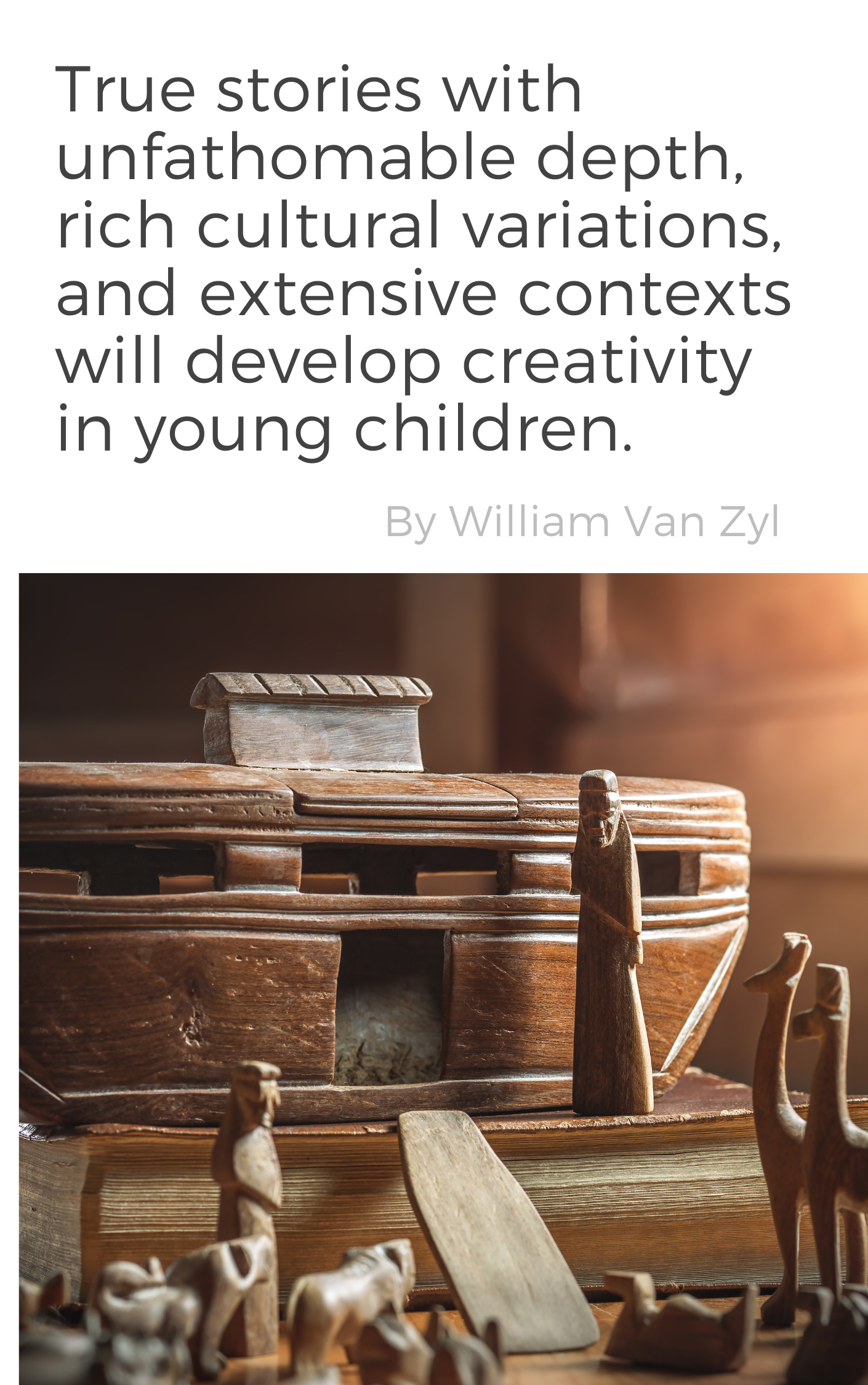
By William Van Zyl
Published in April 2023
Listen to the Podcast:

Do you want to instill extravagantly rich foundations for creativity in your young children?
‘The stories from the Bible are too violent for my young children,’ said the caring mum.
‘I prefer different stories which do not include violence,’ said another mum.
‘The stories from the Bible are probably the best stories you can ever tell your children. Those stories are fine; they will not harm young children. Have you ever heard of anyone – referring to adults who have been exposed to Bible stories as young children – complaining that they have been hurt or negatively impacted by Bible stories?’ said a third mum also present in the conversation.
‘In fact, the most famous stories and movies ever made include Biblical parallels and truths. Just last night (9 April 2023), I watched ‘The Shawshank Redemption,’ written by Stephen King. The Biblical truths that form this movie’s underlying creative foundations are stunning. It inspires, and it gives hope. Andy Dufresne – the innocent inmate – holds on to hope. Also consider Lord of The Rings, The Green Mile, Chronicles of Narnia, and more,’ said the third mum.
—————————–0——————————–
Table of Contents
Here are a couple examples of extravagantly rich storytelling from famous movies.
“ Judgement cometh and that right soon…” Link to the short video: https://youtu.be/cdHoc3bzX8U.
The Shawshank Redemption: ‘Redemption lies within’
The warden said these words while handing a Bible to Andy. The warden was referring to the idea that spiritual salvation could be found within the pages, but he was unaware that Andy had hidden his rock hammer, which he would use to dig out of prison, inside the book. So, it has a double meaning. Andy’s literal salvation was inside the book, so the warden’s comment also worked for that, even though the warden didn’t know about the rock hammer.
‘Redemption lies within.’ Andy (an innocent inmate) hides the rock hammer inside his Bible. Note the shape of the rock hammer starts at the beginning of the book of Exodus (Moses: ‘Let my people go.’). The Israelites escape the bondage of Egypt. It also points to Yeshua’s death and resurrection: ‘Who sets the captives free and prepares a new home for them on earth (promised land) and in heaven. The many layers in this imagery are stunning. The Bible provides the most extravagant, rich symbolism we can find in the world’s literature. Link to the video with commentary: https://youtu.be/QaoKEOHVSkw
A scene from the movie ‘Escape from Alcatraz (Clint Eastwood).’ Here the inmate hides a nail clipper inside his Bible. He uses it to scrape around the air vent – making a hole in his cell to escape from. Link to summary video: https://youtu.be/rNvwnCAfKzM. Escape from Alcatraz is a 1979 American prison action thriller film directed by Don Siegel. It is an adaptation of the 1963 non-fiction book of the same name by J. Campbell Bruce and dramatises the 1962 prisoner escape from the maximum security prison on Alcatraz Island.
———————-0———————-
Have you ever considered Bible Stories as too violent for young children?
Have you been told Bible Stories when you were young? What are your experiences regarding stories? Have you been told different stories? What were those stories? How did it impact your life, reflecting back as an adult?
I will share my experiences.
Well, I must admit that I have been exposed to all the Bible Stories since I can remember as a young child. My experiences are all positive. In fact, those stories have impacted me in a very special and optimistic way: I don’t fear – I have faith in God. I have heard, and I have experienced His comforting words; I understand His character through listening to those richly layered stories. I understand that ‘The Fear of the Lord is the beginning of Wisdom.’ I trust in Him.
I have been researching the topic: ‘Bible Stories are too violent for young children.’ After reading many articles and posts, I have listed the impacts listed and also comments by some other authors for you. Here they are.
Bible Stories have the ability to impact children of all ages – including adults – in a significant way:
- It develops the Fear of God in children (e.g. children that dishonour their parents are stoned to death)
- It highlights the difference between a Theocracy and a Democracy (e.g. God says [His Theocracy], ‘this is the deal, you don’t get to vote’).
- It demonstrates the contrast between God’s Wrath and His Unfailing love (e.g., sending His Son Jesus to Earth to die for our sins). His wrath was released on His Son – for the sins of the world – to provide complete propitiation [appeasement] for our sins and our healing; Jesus’ unfailing love for people giving up His life for his friends – all of us).
- It emphasises the stark Dichotomies in the Bible: Black and White, Right and Wrong, Light and Darkness, Building and Destroying, Blessing and Cursing. For example, Gehazi and Elijah: A servant of the prophet Elisha, Gehazi enjoyed a position of power but was ultimately corrupt, misusing his authority to cheat Naaman the Syrian, a general afflicted with leprosy. As punishment, Elisha cursed Gehazi, transferring Naaman’s leprosy to him and his descendants forever.
- It explains and demonstrates the difference between The Old Covenant and the New Covenant (Old Testament versus New Testament). E. g. The brutal events in the stories of the Old Testament versus the more humane government of God (grace and mercy of God) in the New Testament and beyond.
- It explains God’s Blessings and Cursings (e.g. King Saul chooses to disobey God – Saul did not utterly destroy a city which God commanded him to do. A cursing followed – God’s presence and annointing departed from him)).
- It expounds on the Consequences of Man’s Choices and Actions (e.g. choice to serve other gods – Jehovah is a jealous God – it has severe consequences).
- It shows how God issues warnings (e.g. destroying Sodom and Gomorrah with fire and brimstone).
- It shows His Kindness and His care (e.g. Jesus turning water into wine at a wedding).
- God has supernatural powers which He utilises from time to time
- God Responds to Faith (e.g. David placed his faith in God and consequently defeated Goliath).
- It develops a child’s moral compass. It reinforces crucial aspects of How His Kingdom works, story upon story. For example, ‘Thou shalt not Steal.’)
- It underlines the unchangeable laws, statutes, and precepts of God’s Kingdom (ancient landmarks). For example, the Ten Commandments).
- It develops creativity and innovation in a child, providing an immense range of contexts and cultures (e.g. the different contexts and cultures throughout the history of the Bible)
- It teaches about discipline, including obedience and submission (e.g. Daniel praying to Jehovah 3 times a day).
- It teaches how to pay honour and respect to people and things (e.g. Honouring parents and God’s Laws)
- It teaches what commitment and a covenant are (e.g. truthful marriage and making a choice to serve God)
- It is culturally responsive. I include an excerpt from the article by Mvududu (2009, p.7). ‘Culturally Responsive Teaching: The Bible Tells Me So.’
“To reiterate, as Christians, we are required to be stewards of the gospel. This requires cultural competence. We cannot communicate the gospel to others if we do not understand what their culture is about (Coleman, 1998). Without understanding the signs and images of a particular culture, we can’t communicate what we consider significant. Altering the worship customs of any group is not consistent with multicultural sensitivity. Similarly, using a one size fits all approach to teaching does not effectively meet the needs of our students. Each group brings unique contributions to the Lord’s Table, and we can learn from each other. Looking at those different from us through uninformed assumptions is like looking at an image through a broken mirror. The reflection is distorted even though the image itself is valid. As Breckenridge & Breckenridge (1997) put it, “to cross into other cultures is the expected norm for God’s people, not the exception” (p.77). By preserving rather than covering up or ignoring diversity, we are being more faithful to the Bible and the complexities of life (Rhoads, 1996). Diversity should be constructive rather than the oppression of those with whom we don’t agree. It should not lead to an attitude of superiority and intolerance (Mvududu, 2009, p.7).”
For your information, I’ve also listed important things to remember when telling Bible Stories.
Essential things to implement when telling Bible Stories.
- Never change or tweak the truth of a Bible Story.
- Don’t colour in the stories. Keep it accurate (the truth, nothing but the truth).
- Change the sensitive words temporarily if needed (e.g. adultery – David/Bathsheba) to make the story more age-appropriate; when the child reaches an age where he or she can understand the concepts and words, use the original words.
- Rich, detailed pictures, artwork, short videos, and sketches provide an extravagant backdrop to illustrate the unique stories.
- Sound files (podcasts) provide an additional level of enjoyment and drama.
Lastly, abstract art displaying creativity (Michel Keck – self taught artist):

The text in this work is from the scripture Psalm 37:23-24 and reads: Those whose steps are guided by the LORD, whose way God approves, May stumble but they will never fall, for the LORD holds their hand. PSALM 37:23-24 – Original Scripture Art Painting by Michel Keck – 40″ x 30″ x 1.5″. Link to artwork: https://www.keckfineart.com/products/071802-br-psalm-37-23-24-br-original-scripture-painting
References:
Mvududu, N. (2009). Culturally Responsive Teaching: The Bible Tells Me So. International Christian Community of Teacher Educators Journal, 5(1). https://doi.org/-
Copyright © 2023 by William Van Zyl
True stories with unfathomable depth, rich cultural variations, and extensive contexts will develop creativity in young children.
All rights reserved. This eBook/article or any portion
thereof may not be reproduced or used in any manner
without the publisher’s express written permission, except for the use of brief quotations in a book review.
Published by Five House Publishing (New Zealand)
First Publishing, April 2023
More eBooks and articles are available at https://fivehousepublishing.com/
More about the author at http://williamvanzyl.com/